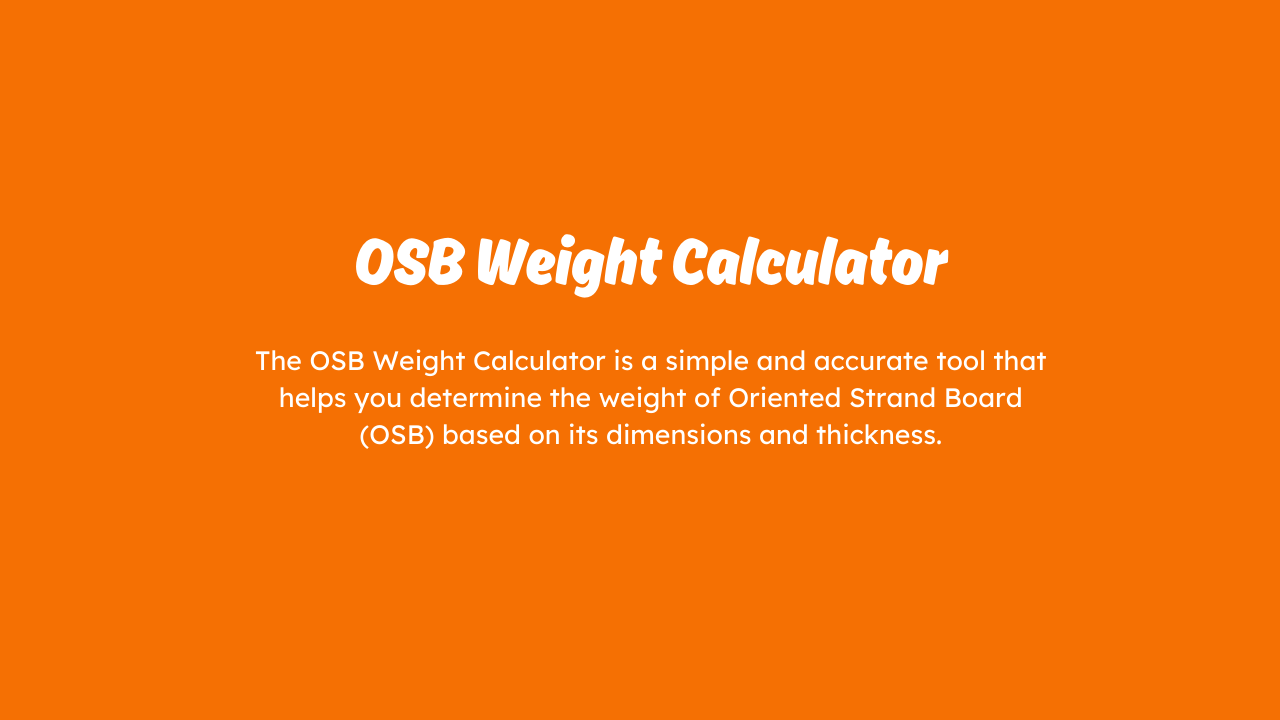Oriented strand board (OSB) is an engineered wood product made by compressing layers of wood strands. Due to its tensile strength and lower cost, it is widely used in the building construction of roofing, flooring, and wall sheathing.
If OSB is a part of your project, you'll want to know its weight for transport, structural load calculations, and materials planning. The OSB Weight Calculator will calculate the weight by length, width, thickness, and OSB density.
In this page, we will cover the formula and how to use it, step-by-step, with a worked example.
Formula for OSB Weight Calculation
Weights of OSB boards are calculated with the following formula:
Weight=Volume×Density
Where:
- Weight = Total weight of the OSB board (in lbs or kg)
- Volume = Length × Width × Thickness (in cubic feet)
- Density = OSB density, assumed to be 40 lbs/ft³
Formula for Volume Calculation
To find the volume of the OSB board:
Volume=Length×Width×Thickness
Where:
- Length = OSB board length (in feet)
- Width = OSB board width (in feet)
- Thickness = OSB board thickness (in feet)
Once the volume is calculated, multiply it by OSB density (40 lbs/ft³) to get the total weight.
Formula for Weight Conversion (to kg)
If you want to convert weight from pounds (lbs) to kilograms (kg), use the conversion factor:
Weight (kg)=Weight (lbs)×0.4536
This is useful when working with metric measurements.
Example Calculation
Let’s say we have an OSB board with the following dimensions:
- Length = 8 feet
- Width = 4 feet
- Thickness = 0.75 inches (convert to feet → 0.75 ÷ 12 = 0.0625 feet)
Step 1: Calculate Volume
Volume=8×4×0.0625=2 cubic feet
Step 2: Calculate Weight in Pounds (lbs)
Weight=2×40=80 lbs
Step 3: Convert to Kilograms (kg)
Weight (kg)=80×0.4536=36.29 kg
Final Result:
The total weight of the OSB board is 80 lbs (36.29 kg).
Conclusion
The OSB Weight Calculator is essential for Oriented Strand Board Calculation It makes it easier to estimate weight, which streamlines transport, installation, and project planning.
FAQ
What is OSB used for?
OSB is extensively popular in construction, flooring, roofing, structural panels, furniture, and DIY projects and wall sheathing. It is also a cheap and strong material alternative for plywood.
How does OSB compare to plywood for strength?
OSB is a strong, and very durable, persuading it similar to plywood, but slightly heavier. It has much higher shear strength, which makes it suitable for load-bearing applications. On the other hand, Plywood is more moisture tolerant than OSB, which can soak up moisture and swell if not properly sealed.
Can OSB be used outdoors?
Yes, but it should be sealed properly or treated for outdoor use. OSB is susceptible to swelling and degradation when exposed to moisture over time. Again, when using OSB outdoors, choose either moisture-resistant OSB or exterior-grade OSB, and seal it or apply coatings to protect it from humidity and rain.

Check out 2 similar OSB Weight Calculator :